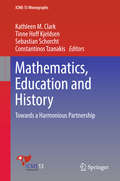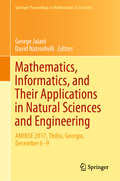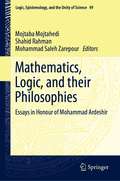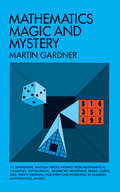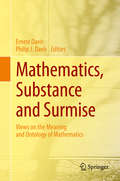- Table View
- List View
Mathematics, Education and History: Towards A Harmonious Partnership (ICME-13 Monographs)
by Kathleen M. Clark Tinne Hoff Kjeldsen Sebastian Schorcht Constantinos TzanakisThis book includes 18 peer-reviewed papers from nine countries, originally presented in a shorter form at TSG 25 The Role of History of Mathematics in Mathematics Education, as part of ICME-13 during. It also features an introductory chapter, by its co-editors, on the structure and main points of the book with an outline of recent developments in exploring the role of history and epistemology in mathematics education. It serves as a valuable contribution in this domain, by making reports on recent developments in this field available to the international educational community, with a special focus on relevant research results since 2000. The 18 chapters of the book are divided into five interrelated parts that underlie the central issues of research in this domain: 1. Theoretical and conceptual frameworks for integrating history and epistemology in mathematics in mathematics education; 2. Courses and didactical material: Design, implementation and evaluation; 3. Empirical investigations on implementing history and epistemology in mathematics education; 4. Original historical sources in teaching and learning of and about mathematics; 5. History and epistemology of mathematics: Interdisciplinary teaching and sociocultural aspects. This book covers all levels of education, from primary school to tertiary education, with a particular focus on teacher education. Additionally, each chapter refers to and/or is based on empirical research, in order to support, illuminate, clarify and evaluate key issues, main questions, and conjectured theses raised by the authors or in the literature on the basis of historical-epistemological or didactical-cognitive arguments.
Mathematics, Grade 5 (Texas Coach)
by Triumph LearningThis book helps you strengthen your mathematics skills. These skills are important to have for every subject you study this year, not just Mathematics. Each lesson in this book has three parts: I GETTING THE IDEA: Review some of the basic concepts and skills you've already learned. II COACHED EXAMPLE: Solve a problem. There are several questions that will help you along the way! III LESSON PRACTICE: Now you're on your own! This part contains more problems to solve. There are different types of test items in Texas Coach. For some, you will have to choose one answer from several possible choices. For others, you will grid in the numbers for your answer. Be sure to read the directions carefully so you know how to answer each item.
Mathematics, Informatics, and Their Applications in Natural Sciences and Engineering: AMINSE 2017, Tbilisi, Georgia, December 6-9 (Springer Proceedings in Mathematics & Statistics #276)
by George Jaiani David NatroshviliThis book presents eleven peer-reviewed papers from the 3rd International Conference on Applications of Mathematics and Informatics in Natural Sciences and Engineering (AMINSE2017) held in Tbilisi, Georgia in December 2017. Written by researchers from the region (Georgia, Russia, Turkey) and from Western countries (France, Germany, Italy, Luxemburg, Spain, USA), it discusses key aspects of mathematics and informatics, and their applications in natural sciences and engineering. Featuring theoretical, practical and numerical contributions, the book appeals to scientists from various disciplines interested in applications of mathematics and informatics in natural sciences and engineering.
Mathematics, Logic, and their Philosophies: Essays in Honour of Mohammad Ardeshir (Logic, Epistemology, and the Unity of Science #49)
by Shahid Rahman Mojtaba Mojtahedi Mohammad Saleh ZarepourThis volume is a collection of essays in honour of Professor Mohammad Ardeshir. It examines topics which, in one way or another, are connected to the various aspects of his multidisciplinary research interests. Based on this criterion, the book is divided into three general categories. The first category includes papers on non-classical logics, including intuitionistic logic, constructive logic, basic logic, and substructural logic. The second category is made up of papers discussing issues in the contemporary philosophy of mathematics and logic. The third category contains papers on Avicenna’s logic and philosophy.Mohammad Ardeshir is a full professor of mathematical logic at the Department of Mathematical Sciences, Sharif University of Technology, Tehran, Iran, where he has taught generations of students for around a quarter century. Mohammad Ardeshir is known in the first place for his prominent works in basic logic and constructive mathematics. His areas of interest are however much broader and include topics in intuitionistic philosophy of mathematics and Arabic philosophy of logic and mathematics. In addition to numerous research articles in leading international journals, Ardeshir is the author of a highly praised Persian textbook in mathematical logic. Partly through his writings and translations, the school of mathematical intuitionism was introduced to the Iranian academic community.
Mathematics, Magic and Mystery
by Martin GardnerWhy do card tricks work? How can magicians do astonishing feats of mathematics mentally? Why do stage "mind-reading" tricks work? As a rule, we simply accept these tricks and "magic" without recognizing that they are really demonstrations of strict laws based on probability, sets, number theory, topology, and other branches of mathematics.This is the first book-length study of this fascinating branch of recreational mathematics. Written by one of the foremost experts on mathematical magic, it employs considerable historical data to summarize all previous work in this field. It is also a creative examination of laws and their exemplification, with scores of new tricks, insights, and demonstrations. Dozens of topological tricks are explained, and dozens of manipulation tricks are aligned with mathematical law.Nontechnical, detailed, and clear, this volume contains 115 sections discussing tricks with cards, dice, coins, etc.; topological tricks with handkerchiefs, cards, etc.; geometrical vanishing effects; demonstrations with pure numbers; and dozens of other topics. You will learn how a Moebius strip works and how a Curry square can "prove" that the whole is not equal to the sum of its parts.No skill at sleight of hand is needed to perform the more than 500 tricks described because mathematics guarantees their success. Detailed examination of laws and their application permits you to create your own problems and effects.
Mathematics, Science, and Postclassical Theory
by Barbara Herrnstein Smith Arkady PlotnitskyMathematics, Science, and Postclassical Theory is a unique collection of essays dealing with the intersections between science and mathematics and the radical reconceptions of knowledge, language, proof, truth, and reality currently emerging from poststructuralist literary theory, constructivist history and sociology of science, and related work in contemporary philosophy. Featuring a distinguished group of international contributors, this volume engages themes and issues central to current theoretical debates in virtually all disciplines: agency, causality, determinacy, representation, and the social dynamics of knowledge. In a substantive introductory essay, the editors explain the notion of "postclassical theory" and discuss the significance of ideas such as emergence and undecidability in current work in and on science and mathematics. Other essays include a witty examination of the relations among mathematical thinking, writing, and the technologies of virtual reality; an essay that reconstructs the conceptual practices that led to a crucial mathematical discovery--or construction--in the 19th century; a discussion of the implications of Bohr's complementarity principle for classical ideas of reality; an examination of scientific laboratories as "hybrid" communities of humans and nonhumans; an analysis of metaphors of control, purpose, and necessity in contemporary biology; an exploration of truth and lies, and the play of words and numbers in Shakespeare, Frege, Wittgenstein, and Beckett; and a final chapter on recent engagements, or nonengagements, between rationalist/realist philosophy of science and contemporary science studies. Contributors. Malcolm Ashmore, Michel Callon, Owen Flanagan, John Law, Susan Oyama, Andrew Pickering, Arkady Plotnitsky, Brian Rotman, Barbara Herrnstein Smith, John Vignaux Smyth, E. Roy Weintraub
Mathematics, Substance and Surmise
by Philip J. Davis Ernest DavisThe seventeen thought-provoking and engaging essays in this collection present readers with a wide range of diverse perspectives on the ontology of mathematics. The essays address such questions as: What kind of things are mathematical objects? What kinds of assertions do mathematical statements make? How do people think and speak about mathematics? How does society use mathematics? How have our answers to these questions changed over the last two millennia, and how might they change again in the future? The authors include mathematicians, philosophers, computer scientists, cognitive psychologists, sociologists, educators and mathematical historians; each brings their own expertise and insights to the discussion. Contributors to this volume: Jeremy Avigad Jody Azzouni David H. Bailey David Berlinski Jonathan M. Borwein Ernest Davis Philip J. Davis Donald Gillies Jeremy Gray Jesper Lützen Ursula Martin Kay O'Halloran Alison Pease Steven Piantadosi Lance Rips Micah T. Ross Nathalie Sinclair John Stillwell Hellen Verran
